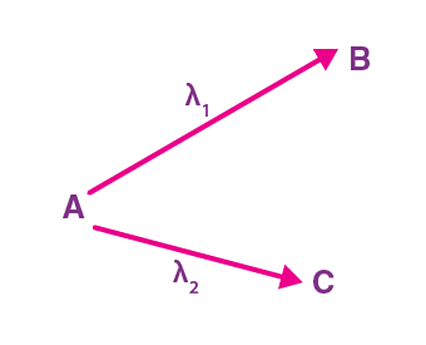A radioactive nucleus can decay by two different processes. Half-life for the first process is 3.0 hours while it is 4.5 hours for the second process. The effective half-life of the nucleus will be:


- 3.75 hours
- 0.56 hours
- 0.26 hours
- 1.80 hours
The Correct Option is D
Solution and Explanation
The correct answer is (D): 1.80 hours
Explanation:
\(\frac{dA }{dt }\)- (-λ1A) + ( -λ2A)
⇒ \(\frac{dA }{dt }\) = - ( λ1 + λ2 )A
⇒ λeff = λ1 + λ2
⇒ \(\frac{ln2}{(t_{1/2})eff }\) = \(\frac{ln2}{(t_{1/2})_1}\) + \(\frac{ln2}{(t_{1/2})_2}\)
⇒ \(( t_{1/2} )\)eff =\(\frac{ 4.5 × 3 }{7.5}\) hours
= 1.8 hours
Top Questions on Nuclei
- In a nuclear fusion reaction, if the mass defect is 0.25%, then the energy released in the fusion of 400 $\mu$g mass of a substance is
- If the mean life of a radioactive sample is 10 minutes, then the time (in minutes) taken for the activity of the radioactive sample to become $\mathrm{e}^{21}$ times its initial activity is
- If the energy released in the fission of one uranium nucleus is 200 MeV, then the number of fissions per second required to produce 20 MW is:
- If the half-life of a radioactive material is 5 days, then the ratio of the number of atoms disintegrated in 10 and 15 days is:
- If the number of uranium nuclei required per hour to produce a power of 64 kW is \(7.2 \times 10^{18}\), then the energy released per fission is
Questions Asked in JEE Main exam
- Let \( A = [a_{ij}] \) be a matrix of order 3 \(\times\) 3, with \(a_{ij} = (\sqrt{2})^{i+j}\). If the sum of all the elements in the third row of \( A^2 \) is \( \alpha + \beta\sqrt{2} \), where \(\alpha, \beta \in \mathbb{Z}\), then \(\alpha + \beta\) is equal to:
- JEE Main - 2025
- Matrices and Determinants
Consider the following sequence of reactions :

Molar mass of the product formed (A) is ______ g mol\(^{-1}\).- JEE Main - 2025
- Organic Chemistry
The magnitude of heat exchanged by a system for the given cyclic process ABC (as shown in the figure) is (in SI units):

- JEE Main - 2025
- Electric charges and fields
- The value of \( (\sin 70^\circ)(\cot 10^\circ \cot 70^\circ - 1) \) is:
- JEE Main - 2025
- Trigonometric Identities
- The number of 6-letter words, with or without meaning, that can be formed using the letters of the word "MATHS" such that any letter that appears in the word must appear at least twice is:
- JEE Main - 2025
- Calculus
Concepts Used:
Nuclei
In the year 1911, Rutherford discovered the atomic nucleus along with his associates. It is already known that every atom is manufactured of positive charge and mass in the form of a nucleus that is concentrated at the center of the atom. More than 99.9% of the mass of an atom is located in the nucleus. Additionally, the size of the atom is of the order of 10-10 m and that of the nucleus is of the order of 10-15 m.
Read More: Nuclei
Following are the terms related to nucleus:
- Atomic Number
- Mass Number
- Nuclear Size
- Nuclear Density
- Atomic Mass Unit